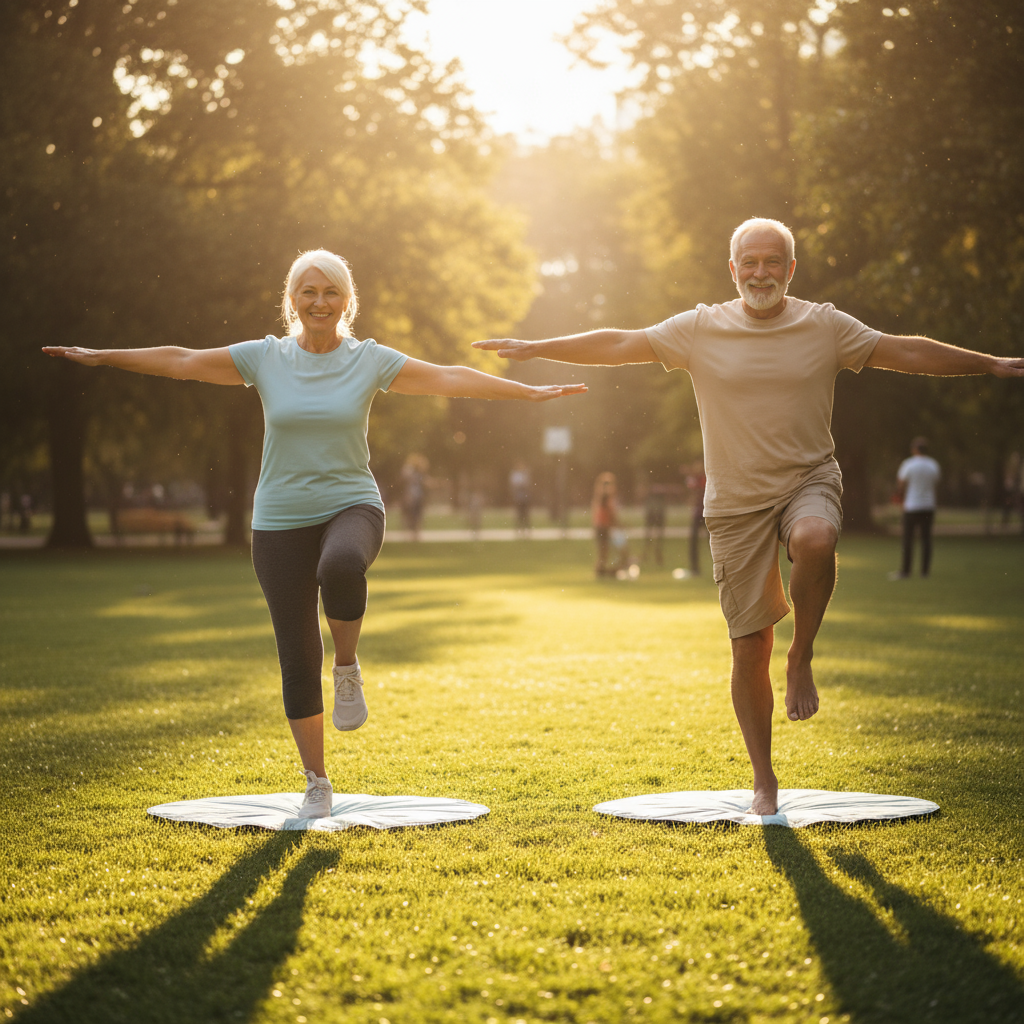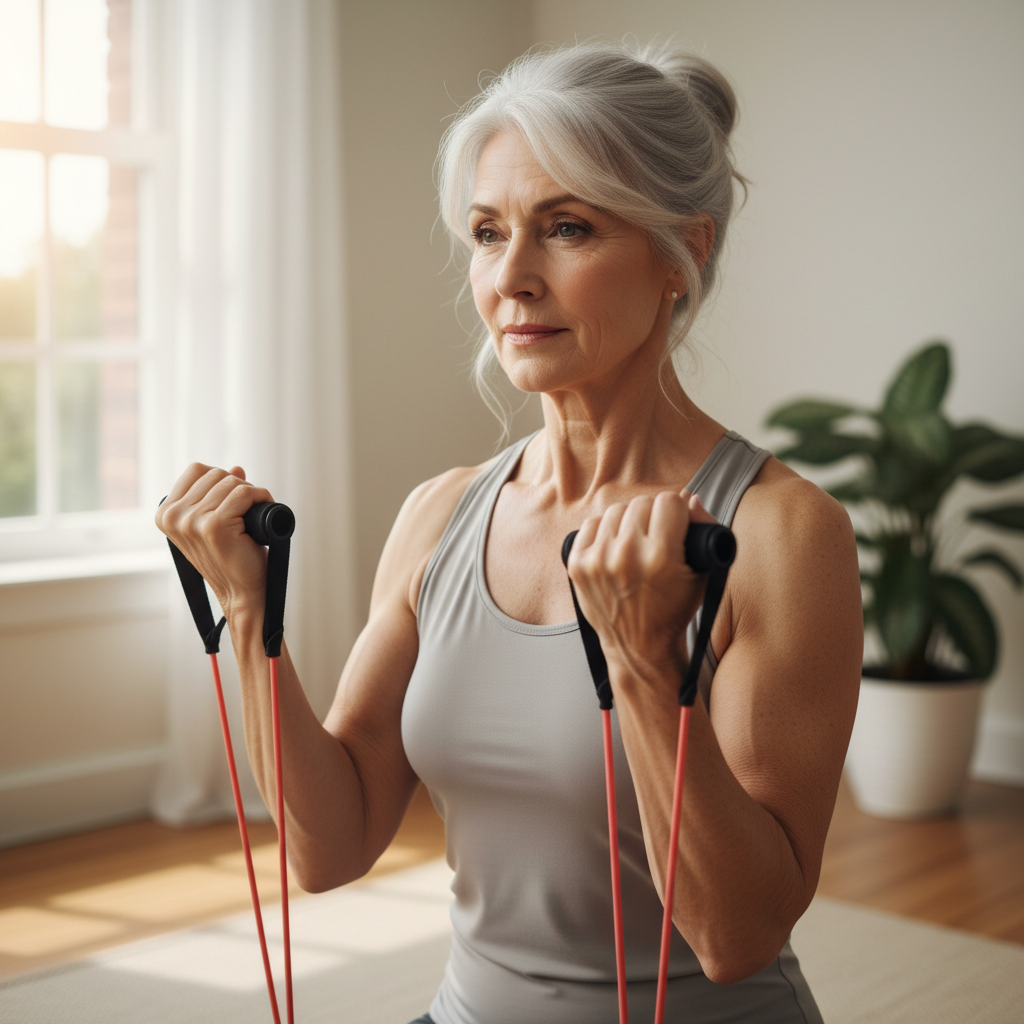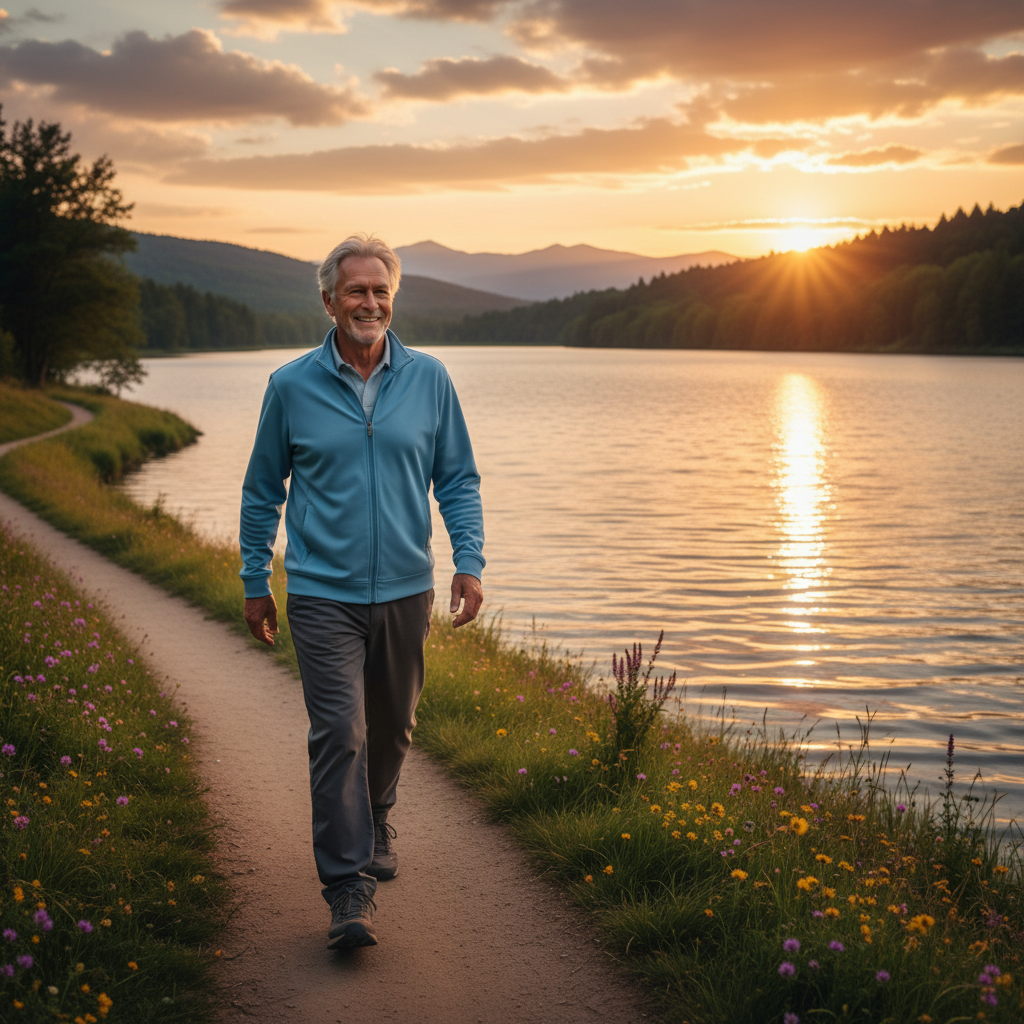
Table of Contents
Introduction
Let’s be honest about something: getting older doesn’t mean slowing down has to be your only option. Sure, your body changes. Your muscles might not bounce back like they used to, and that whole “balance thing” becomes more… interesting. But here’s what I’ve learned from working with countless seniors—the right exercise routine can be absolutely life-changing. We’re talking about staying independent, feeling strong, and keeping that spark that makes life worth living.
You know what really gets me excited? Watching someone in their 70s discover they can still build muscle. Or seeing a grandmother who was afraid of falling become steady on her feet again. Exercise isn’t just about looking good (though that’s a nice bonus)—it’s about feeling good, thinking clearly, and keeping your freedom. Research backs this up big time: seniors who stay active cut their risk of chronic diseases, keep their minds sharp, and genuinely feel better day to day. Now, if you want to get the most bang for your buck, functional fitness workouts are where it’s at. These aren’t fancy gym moves—they’re exercises that help you do real-life stuff better. Getting up from a chair. Carrying groceries. Playing with grandkids. And if you’re thinking “I don’t know where to start,” don’t worry. Plenty of people find their groove with fitness challenges for beginners. Small wins build confidence, and confidence builds habits. Speaking of starting out, knowing how to start a fitness routine the right way means you’ll actually stick with it—and stay safe doing it.
But here’s something people don’t talk about enough: the mental boost you get from moving your body. I’m talking about real, measurable improvements in mood and thinking. Activities like yoga, walking, and tai chi don’t just make you physically stronger—they actually help fight off anxiety and depression. Take tai chi, for example. The benefits of tai chi for seniors go way beyond better balance (though that’s huge). We’re talking stress relief, better focus, and this amazing sense of calm that carries over into daily life. The science behind this stuff is pretty incredible. When you exercise, your brain releases these natural mood boosters while dialing down stress hormones. It’s like having a pharmacy in your own body. If you want to dive deeper into this connection, check out the research on mental health and exercise benefits—it’ll blow your mind.
Now, let’s talk about fueling all this activity. You can’t out-exercise a poor diet, and that’s especially true as we age. Your body needs the right nutrients to build and repair muscle, fight inflammation, and keep your energy steady. Take kale, for instance—this leafy green powerhouse is packed with vitamins and antioxidants that support muscle health and boost your immune system. (Trust me, the nutrition facts about kale will surprise you.) Pairing smart exercise with smart eating is a game-changer. If weight management is part of your goals, understanding healthy meal plans for weight loss can help you maintain an ideal weight while giving your workouts the fuel they deserve.
What You’ll Learn in This Guide
This guide is all about giving you practical, proven strategies for staying active and healthy—no matter what your starting point looks like. Here’s exactly what we’ll cover:
- Benefits of Exercise for Seniors: Discover how regular physical activity improves physical strength, mental clarity, and emotional balance, reducing risks associated with aging and chronic conditions.
- Types of Exercises Suitable for Seniors: Explore cardiovascular workouts, strength training using resistance bands, and activities to enhance flexibility and balance like yoga and tai chi.
- Creating a Personalized Exercise Plan: Learn how to assess your fitness level, set realistic goals, and incorporate variety to keep your routine engaging and effective.
- Safety Tips and Precautions: Understand essential guidelines to prevent injuries, including proper warm-ups, hydration, and listening to your body’s signals for a safe fitness journey.
Throughout this guide, you’ll learn how to adapt every exercise to fit your needs—because let’s face it, we’re all starting from different places. Some of you might be coming back from an injury. Others might be starting from scratch. That’s perfectly okay. What matters is finding a routine that works for you and sticking with it. I’ll share practical tips for staying motivated when the initial excitement wears off, and we’ll tackle those common roadblocks that trip people up. (Spoiler alert: most barriers are mental, not physical.)
We’ll explore everything from simple walking routines that you can start tomorrow to resistance training that builds real, functional strength. Gentle yoga sequences that improve flexibility without intimidation. The social aspects of group classes. How to exercise safely at home. If you’re worried about motivation—and who isn’t?—definitely check out these tips on how to stay motivated to exercise. Because consistency beats intensity every single time.
By the time you finish reading this, you’ll have a clear roadmap for improving your mobility, reducing everyday aches and pains, standing taller, and feeling stronger. Most importantly, you’ll have the confidence to take that first step toward a more vibrant, active life. Ready to get started? Let’s do this together.

So you’ve learned about the amazing benefits exercise can bring to your golden years. Now comes the fun part—figuring out exactly what kinds of workouts will work best for you. Here’s the thing: not all exercises are created equal, especially when you’re 65 or older. Your body has different needs now, and that’s perfectly normal. The key is finding activities that keep you strong, steady, and feeling great while actually being enjoyable to do. We’re going to walk through the best exercise options for seniors, then help you put together a plan that fits your life, your goals, and yes—your comfort zone too.
Types of Exercises Suitable for Seniors
Let’s be honest—the word “workout” might make you think of twenty-somethings grunting over barbells. But here’s what really matters for seniors: exercises that help you live your best life every single day. Think about it. What good is being able to bench press your body weight if you can’t easily get up from a chair or carry groceries without losing your balance?
That’s where functional fitness comes in. These aren’t just random movements—they’re exercises that mirror what you actually do. Getting out of bed, reaching for something on a high shelf, walking up stairs. Functional fitness workouts focus on these real-world movements, building the strength, balance, and coordination that keep you independent. And honestly? They’re pretty satisfying once you realize how much easier daily tasks become.
Your heart needs love too. Cardiovascular exercise doesn’t have to mean running marathons (unless that’s your thing). We’re talking about activities that get your heart pumping and your blood flowing—walking, swimming, cycling, even dancing if that makes you happy. The beauty of cardio for seniors is that it can be as gentle or as challenging as you want it to be. Start with a leisurely walk around the block, and who knows? You might end up training for a 5K.
Now, let’s talk about something crucial: keeping your muscles and bones strong. This is where strength training enters the picture, but don’t worry—we’re not talking about becoming a bodybuilder overnight. Light weights, resistance bands, even your own body weight can work wonders. Your muscles and bones naturally lose density as you age (it’s just biology), but strength training can slow that process dramatically. Plus, there’s something pretty empowering about feeling physically stronger than you did last month.
Flexibility and balance deserve their own spotlight because they’re game-changers for fall prevention. Yoga and tai chi aren’t just trendy—they’re incredibly effective for seniors. These practices combine gentle stretching with controlled movements that improve your posture, keep your joints happy, and reduce injury risk. If you’re new to exercise, starting with bodyweight movements is brilliant. No equipment needed, you can do them at home, and they build real functional strength. For those ready to step it up, kettlebell workouts offer dynamic options that boost both strength and endurance. And if you want to know how to increase flexibility fast, the right stretching routine can make a noticeable difference in just weeks.
Key Aspects of Types of Exercises Suitable for Seniors
When you’re choosing exercises, keep these essential points in mind. They’ll help you get the most benefit while staying safe and injury-free.
- Functional Fitness Benefits: These workouts focus on improving strength, balance, and coordination through whole-body movements tailored to daily activities. Exploring the benefits of functional fitness workouts provides seniors with routines designed to maintain independence and reduce fall risk.
- Cardiovascular Health: Engaging in moderate-intensity cardio activities like walking or swimming boosts heart and lung function. Utilizing resources like cardio workouts for fat burning helps seniors select safe, effective routines that enhance endurance and overall vitality.
- Strength and Muscle Maintenance: Resistance training with light weights or kettlebells builds muscle strength and bone density, essential for aging bodies. Understanding the benefits of kettlebell workouts and safe practices can optimize these efforts.
- Improving Flexibility and Balance: Incorporating exercises like yoga and targeted stretching improves posture, joint health, and falls prevention. Guidance on how to increase flexibility fast allows seniors to enhance their range of motion safely.
The beauty of having all these exercise options? You never have to get bored. Variety keeps things interesting and ensures you’re working different parts of your body. Plus, when you have choices, you’re more likely to stick with it long-term. Next up, we’ll talk about how to take all this information and create a workout plan that’s perfectly tailored to you—your health, your preferences, and your goals.
Creating a Personalized Exercise Plan
Here’s where the rubber meets the road. You know what types of exercises work well for seniors, but how do you create a plan that actually fits your life? It starts with being honest about where you are right now—both physically and mentally.
First things first: talk to your doctor. I know, I know—you’ve heard this advice a thousand times. But here’s why it really matters: your healthcare provider knows your specific health history, medications, and any conditions that might affect your exercise choices. They’re not trying to rain on your fitness parade; they’re helping you exercise safely and effectively. Think of this conversation as getting a personalized roadmap for your fitness journey.
Goal setting comes next, and this is where many people either soar or stumble. The secret? Start smaller than you think you should. Want to walk for 30 minutes a day? Great! Start with 10 minutes and build up. This isn’t about lacking ambition—it’s about creating sustainable habits that stick. When you consistently hit smaller goals, you build confidence and momentum. Before you know it, those “small” goals become your warm-up. If you’re wondering how to start a fitness routine, you’ll find practical strategies for setting realistic milestones and building consistency from day one.
Variety isn’t just the spice of life—it’s the secret ingredient for long-term fitness success. When your routine includes cardiovascular work, strength training, flexibility, and balance exercises, you’re giving your body everything it needs. But more importantly, you’re preventing boredom. Nothing kills a fitness routine faster than dreading your workout.
Let’s talk about motivation, because this is where things get real. Starting a new exercise routine at any age can feel daunting, but doing it later in life comes with its own unique challenges. Your body might not bounce back as quickly as it used to, and comparing yourself to your younger self isn’t exactly motivating. That’s why learning how to stay motivated to exercise becomes crucial. Setting milestones, tracking your progress, and building a support system can make all the difference between giving up after two weeks and creating a lifelong habit.
Want to add some fun to the mix? Consider fitness challenges for beginners. These aren’t about competing with others—they’re about challenging yourself in manageable, enjoyable ways. Maybe it’s walking a certain number of steps per day, holding a plank for progressively longer periods, or trying a new type of exercise each month. Small challenges keep things interesting and give you something to look forward to.
Key Aspects of Creating a Personalized Exercise Plan
Building a successful exercise plan isn’t rocket science, but it does require some thoughtful planning. These components will set you up for long-term success.
- Assessing Physical Health Safely: Prior to starting any new program, consulting health professionals to evaluate conditions and capabilities is crucial. This proactive step supports safe exercise adoption and reduces injury risks.
- Setting Realistic, Achievable Goals: Goals should be specific, measurable, and considerate of individual abilities. Starting small and progressively increasing intensity maintains motivation and supports sustainable improvements.
- Incorporating Exercise Variety: Mixing cardiovascular, strength, flexibility, and balance exercises ensures comprehensive fitness benefits. Variety also keeps routines interesting, preventing burnout and encouraging long-term commitment.
- Utilizing Support and Tracking Progress: Engaging with fitness challenges, support groups, or digital tools fosters accountability and motivation. Tracking improvements over time provides a sense of accomplishment and guides necessary adjustments.

Here’s the thing about exercise as we age—it’s not just about staying fit. It’s about staying you. Regular movement keeps your body strong, your mind sharp, and your spirit bright. And the best part? You don’t need to become a gym warrior to see real benefits. Smart, gentle exercise that fits your life can help you maintain your independence while cutting your risk of chronic diseases and those scary falls we all worry about. When you combine cardio, strength work, and flexibility training, something amazing happens. Your posture improves, your bones get stronger, and suddenly those daily activities feel easier again. Just remember the golden rule: warm up properly, stay hydrated, and listen to what your body tells you.
What I love about senior fitness is how many options you have. Think of it as a buffet—you get to pick what works for you. Functional fitness exercises? They’re like practicing for real life, making everyday tasks feel effortless. Prefer something gentler? Walking or swimming give your heart and lungs exactly what they need without beating you up. And those light weights or resistance bands? They’re your secret weapons against the muscle and bone loss that tries to sneak up on us. Don’t sleep on yoga and tai chi either—these practices are like insurance policies against falls. The key is working with your doctor to create a plan that makes sense for your body and your goals. No cookie-cutter approaches here.
Ready to get moving? Let’s make this simple and doable. Start with functional fitness workouts that build the strength and balance you use every single day. If you’re just getting started (or getting back into it), fitness challenges for beginners can give you that gentle push and sense of community you might be craving. The biggest hurdle is often just beginning, which is why knowing how to start a fitness routine the right way matters so much. Want to move better and feel less stiff? Check out our guide on how to increase flexibility fast—it’s all about safe, effective techniques. And because let’s be honest, motivation can be tricky sometimes, our strategies for how to stay motivated to exercise will help you stick with it when life gets in the way. Don’t forget—exercise isn’t just good for your body. It’s one of the best things you can do for your mood and mental clarity too.
You’ve got all the knowledge you need now. The truth is, starting (or restarting) an exercise routine that actually fits your life can be one of the best decisions you make. It’s not about perfection—it’s about progress. Every step counts, every stretch matters, and every workout is a win. Your future self will thank you for taking care of yourself today. These really can be your best years yet, and staying active is your ticket to making them count. Need an extra boost of motivation along the way? We’ve got you covered with more tips on how to stay motivated to exercise.
Frequently Asked Questions
-
What types of exercises are safest for seniors?
- Low-impact activities like walking, swimming, and stretching are generally safe and beneficial for most seniors, helping improve mobility and reduce injury risk.
-
How often should seniors exercise?
- Seniors should aim for at least 150 minutes of moderate exercise spread throughout the week, tailored to individual health status and comfort.
-
Can seniors with chronic conditions exercise safely?
- Yes, with medical clearance and appropriate modifications, many seniors with chronic conditions can safely engage in tailored exercise programs.
-
What should I do if I experience pain during exercise?
- If pain occurs, stop exercising immediately and consult a healthcare professional to prevent injury and assess the cause.
